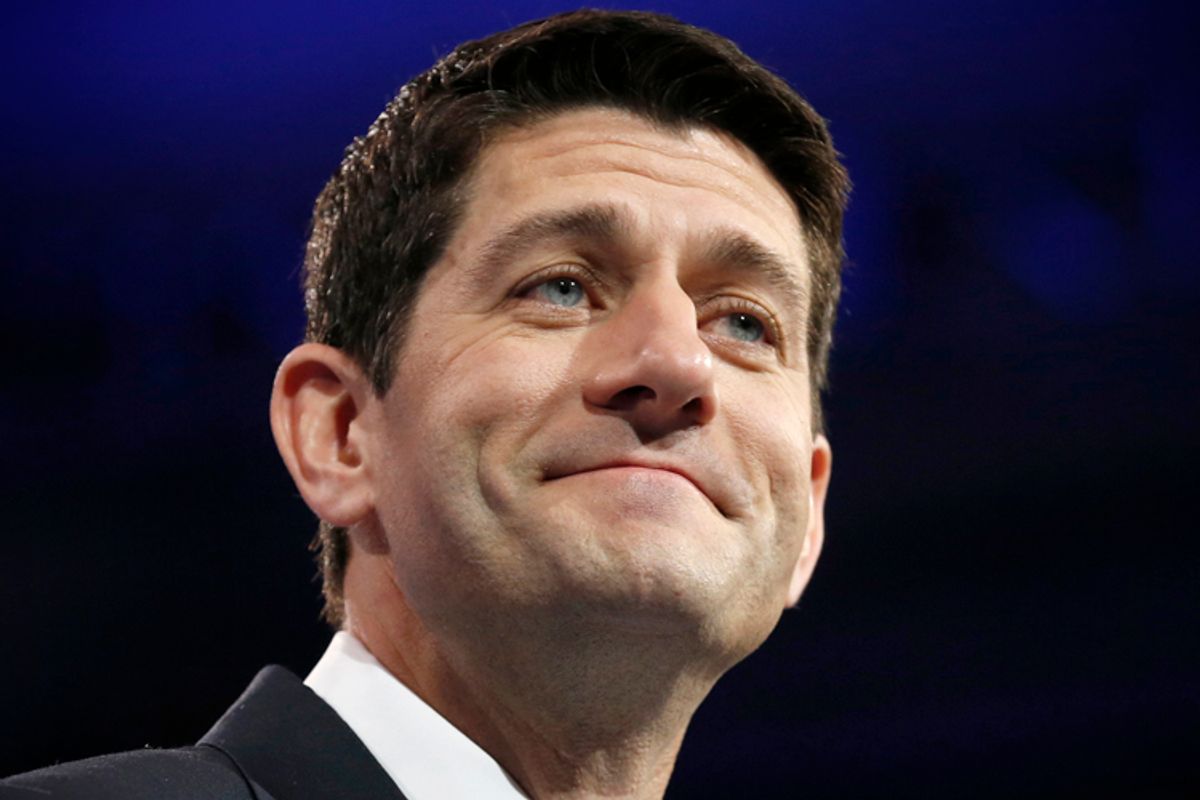The so-called reform conservatives released a book of policy proposals last week to much fanfare. On the whole, it’s the usual hodgepodge of conservative ideas, though dressed up in slicker graphics. There is the ever-present call to repeal Obamacare in favor of tax credits, which is neither new nor interesting. There is the “drill baby drill” energy policy that makes not even a single mention of climate change. But the biggest horror show of all is the tax reform proposal, which is nothing more than the usual screw-the-poor pablum.
At its essential core, the reform conservative tax plan is actually two proposals. The first proposal gets rid of our seven marginal tax rates that span from 10 to 40 percent and replaces them with two marginal tax rates of 15 and 35 percent. The second proposal massively expands the American welfare state by dramatically increasing the cash transfers parents of children receive. Well, it increases the cash transfers some parents will receive, namely middle- and upper-class parents, while totally neglecting the rest.
More specifically, their proposed welfare state expansion consists of adding a $2,500 child tax credit to the existing $1,000 child tax credit and personal tax exemption for children. Although a massive expansion in child-related welfare spending is a great idea, the restrictions the reform conservatism plan places on who can claim these benefits leaves poor families totally out in the cold.
The two pieces of the child benefit welfare state that they keep intact — the personal tax exemption and $1000 child tax credit — already deliver far more benefits to middle and upper class families than to poor families. This is because the personal tax exemption operates as an income deduction, meaning the amount of benefit families receive from it increases as their marginal tax rate increases. In 2013, families with incomes that placed them in the 10% tax bracket received $390 of benefits from the personal exemption for each of their children. Families in the 33% tax bracket received $1,287 of benefits.
The $1,000 child tax credit is not quite so lopsided, but it has the same basic defects. In theory, every family would receive exactly $1,000 of benefits for each of their children. But poor families that do not have $1,000 in tax liability do not receive the full amount of the benefit because the credit is only semi-refundable. The additional $2,500 child tax credit proposed in this plan is even worse on this front because it is not refundable at all and the number of families without enough tax liability to claim its full benefit is significantly higher.
The net affect of all of this is that, under the proposal, a family making $70,000 per year who had twins would receive more than $7,000 per year in child welfare payments via the tax code. A family making $10,000 or $15,000 per year who had twins might receive a few hundred dollars in child welfare payments, if any at all. They’d also have the pleasure of seeing their current federal income tax rate of 10 percent bump up to 15 percent.
Needless to say, this is grotesque, vicious and cruel. It even gives Paul Ryan’s annual budget horror show a run for its money in the contest of who can come up with the most poor-hating idea. If we want to provide welfare income to parents to help them raise their kids, a good idea in my view, then it should be provided equally to all parents, for instance through a flat child allowance.
What’s remarkable in this case is that the reform conservative’s own arguments point in the direction of using a child allowance rather than their current screw-the-poor approach. They can’t argue for expanding the welfare state like normal people do because they are conservatives. So they have to revert to weird, tortured gimmicks to pretend that’s not what they are doing.
Here, the tortured gimmick they opt for is to say that these child benefits are called for because children grow up to pay into the Social Security and Medicare system. Thus, parents who raise children are sort of also contributing in taxes all of the money their kids will pay into these retirement security programs. Thus, to offset that additional tax paid by their kid when they are grown, the parents should receive these benefits. It’s not welfare, you see. It’s actually just an offset for taxes the children will pay way in the future. Got that? Probably not, because it makes no sense.
But supposing they can make some sense of that argument, what does it actually tell us about how to structure these child benefits? If the goal of the benefits is to pay parents for the Social Security and Medicare contributions of their children, then all parents should receive the same benefits. The children of poor parents will grow up to pay into the Social Security and Medicare system just as the children of middle and upper class parents will. If the goal is truly to offset those future payments of the kids, it makes no sense to provide child benefits based upon the incomes of the parents.
So by their own bizarre argument, the reform conservatives are making the case for a flat child allowance system in which all families receive identical benefits for their children. But instead of that, they’ve proposed a system where richer parents get tens of thousands of dollars more in child benefits than poorer parents, the poorest of whom will get no benefits at all. Meet the new conservatives, same as the old conservatives.

Shares